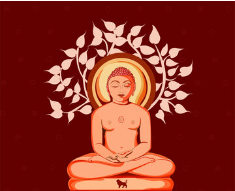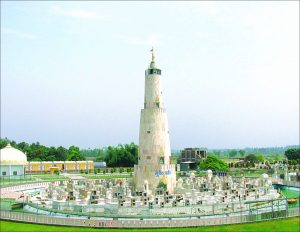णमो अरिहंताणं
|
जैनधर्म के ज्ञान की अखंडज्योति
|
णमो अरिहंताणं
|
जैनधर्म के ज्ञान की अखंडज्योति
|
|



Written by – Ganinee Pramukh Shri Gyanmati Mataji
Translated by – Aryika Swarnmatil
Lord Mahavira is the 24th Thirthankar of Jain Religion. He is a glowing light of knowledge in the lineage of Jainism. Lord Mahavir was born on the thirteenth day of rising moon of Chaitra month (”Chaitra Shukla Trayodashi”), in 599 B.C. in ”Kundalpur” (Nalanda dist.)
Bihar, India. This day falls in the month of March-April as per Gregorian calendar. Though the most well-known figure in Jainism and a great propogator, one should not mistake him for the founder of the Jina Dharma. Jain Dharma is anadhinidhan( Neither formed nor perishable).
Indra formed Ayodha Nagari owing to the ”Punya’‘ of King Nabhiraj and queen Marudevi. ”Kalpavrikshas”(trees which provide any wished article) were almost on the verge of extinction at that time, so Nabhiraj directed the public to eat fruits and drink ”Ikshuras”( Sugarcane juice). That’s why he was also called as “IKSHVAKUVANSHI”. Queen Marudevi gave birth to Tirthankar Vrishabhdeva. Then Devtas and Indras combinedly celebrated the ”Janmabhishek” festival(ceremony of anointment of the newborn infant) by taking the Jin-Child to the ”Sumeru” mountain.
After Rishabhdev became young, he was married to Yashasvati and Sunanda. Yashasvati gave birth to Bharat Chakravarti & 99 sons and also to ”Brahmi” daughter whereas Queen Sunanda gave birth to ”Bahubali kamdev” and ”Sundari” daughter.Read More…
 ऐतिहासिक तीर्थक्षेत्र हस्तिनापुर अयोध्या के समान ही अत्यन्त प्राचीन एवं पवित्र माना जाता है। जिस प्रकार जैन पुराणों के अनुसार अयोध्या नगरी की रचना देवों ने की थी उसी प्रकार युग के प्रारंभ में हस्तिनापुर की रचना भी देवों द्वारा की गयी थी। अयोध्या में वर्तमान के पाँच तीर्थंकरों ने जन्म लिया तो हस्तिनापुर को शान्तिनाथ, कुन्थुनाथ, अरहनाथ इन तीन तीर्थंकरों को जन्म देने का सौभाग्य प्राप्त हुआ है। इतना ही नहीं, इन तीनों जिनवरों के चार-चार कल्याणक (गर्भ, जन्म, तप, ज्ञान) हस्तिनापुर में इन्द्रों ने मनाए हैं ऐसा वर्णन जैन ग्रंथों में है।
ऐतिहासिक तीर्थक्षेत्र हस्तिनापुर अयोध्या के समान ही अत्यन्त प्राचीन एवं पवित्र माना जाता है। जिस प्रकार जैन पुराणों के अनुसार अयोध्या नगरी की रचना देवों ने की थी उसी प्रकार युग के प्रारंभ में हस्तिनापुर की रचना भी देवों द्वारा की गयी थी। अयोध्या में वर्तमान के पाँच तीर्थंकरों ने जन्म लिया तो हस्तिनापुर को शान्तिनाथ, कुन्थुनाथ, अरहनाथ इन तीन तीर्थंकरों को जन्म देने का सौभाग्य प्राप्त हुआ है। इतना ही नहीं, इन तीनों जिनवरों के चार-चार कल्याणक (गर्भ, जन्म, तप, ज्ञान) हस्तिनापुर में इन्द्रों ने मनाए हैं ऐसा वर्णन जैन ग्रंथों में है।
आज से लगभग पौन पल्य ६६ लाख ८६ हजार ५२९ वर्ष पूर्व हस्तिनापुर के राजा विश्वसेन की महारानी ऐरादेवी की पवित्र कुक्षि से ज्येष्ठ कृष्णा चतुर्दशी के दिन सोलहवें तीर्थंकर भगवान शांतिनाथ ने जन्म लिया था पुन: राजा सूरसेन की महारानी श्रीकांता ने वैशाख शुक्ला एकम तिथि में सत्रहवें तीर्थंकर कुन्थुनाथ को जन्म दिया तथा राजा सुदर्शन की महादेवी मित्रसेना के पवित्र गर्भ से मगशिर शु. १४ को १८वें तीर्थंकर भगवान अरहनाथ का जन्म हुआ था। इस प्रकार तीन बार यहाँ पर १५-१५ मास तक कुबेर ने अगणित रत्नों की वृष्टि की थी अत: रत्नगर्भा नाम से सार्थक यह भूमि प्राणिमात्र को रत्नत्रय धारण करने की प्रेरणा प्रदान करती है। ये तीनों तीर्थंकर चक्रवर्ती और कामदेव पदवी के धारक भी थे। प्रथम तीर्थंकर भगवान ऋषभदेव को एक वर्ष ३९ दिन के उपवास के पश्चात् हस्तिनापुर में ही युवराज श्रेयांस एवं राजा सोमप्रभ ने इक्षुरस का प्रथम आहार दिया था।
 प्रस्तुति- आर्यिका चंदनामती
प्रस्तुति- आर्यिका चंदनामती
संसार और मोक्ष की समस्त व्यवस्था कर्म के आधीन है। जिस सृष्टि की रचना में लोक परम्परानुसार ब्रह्माजी को कर्तारूप में माना जाता है, जैन सिद्धान्त के अनुसार वह ब्रह्मा और कोई नहीं, कर्म ही है।
आचार्य श्री नेमिचन्द्र सिद्धान्तचक्रवर्ती ने कहा भी है—
देहोदयेण सहिओ जीवो आहरदि कम्म णोकम्मं।
पडिसमयं सव्वंगं तत्तायसिंपडओव्व जलं।।
अर्थात् यह जीव औदारिक आदि शरीर नामकर्म के उदय से योग सहित होकर ज्ञानावरणादिक आठ कर्मरूप होने वाली कर्म वर्गणाओं को तथा औदारिक आदि चार शरीर रूप होने वाली नोकर्म वर्गणाओं को हर समय चारों तरफ से ग्रहण करता है। जैसे कि आग से तपा हुआ लोहे का गोला पानी को सब ओर से अपनी तरफ खींचता है।
(१) ज्ञानावरण,
(२) दर्शनावरण,
(३) वेदनीय,
(४) मोहनीय,
(५) आयु,
(६) नाम,
(७) गोत्र
(८) अन्तराय। Read More…